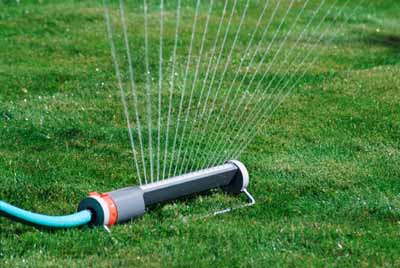Without water, plants wilt and die. But too much water can be as bad for plants as not enough. If land plants are submerged in water for too long, even if just their roots are submerged, they may rot or drown from lack of oxygen.
Balancing plants’ water needs is like having a healthful diet. Everything should be consumed in moderation. Provide your plants with enough water for good health, but don’t flood them with it.
Watering Guidelines
Watering your plants involves a bit more than just throwing a sprinkler on them every other day — although this is better than not watering them at all! Use the following tips to get the maximum benefit out of your watering efforts.
- Apply water in the cool of the morning or evening when the wind is calm and water loss through evaporation is minimal.
- Avoid watering disease-susceptible plants at night. If water sits on plant foliage for hours, it can encourage fungal diseases to attack leaves, buds, flowers, and fruit. Plants susceptible to leaf spots, fruit rots, and flower blights are best watered in the morning, when the warming sun will quickly dry the leaves and discourage fungus development.
- Provide an inch of water a week for many plants and lawn grasses. The idea is to keep the soil lightly moist and to prevent it from drying out completely, which would be damaging to most plants. But because plants don’t always follow the rules, there are exceptions to this general guideline:
- More water may be necessary if you have hot weather, dry sandy soil, or crowded intensive plantings or containers.
- When the weather is cool, the plants are widely spaced, or the soil is heavy and moisture-retentive, less water may be required.
- Young or new plantings require more moisture at the soil surface to help their roots get established. You should water more often to accommodate their needs.
- Mature plantings with large root systems can be watered heavily and less often than younger plants. The moisture soaks deep into the soil and encourages the roots to thrive.
- Set a rain gauge in an open area of the garden to learn how much water the garden receives each week. You can purchase an inexpensive one at a garden center. After each rainfall, check the depth of the rain inside. A commercial rain gauge is calibrated and easy to read. Judge the need for supplemental irrigation accordingly.
Rain gauges are also helpful when trying to determine when you have watered enough with an overhead sprinkler. Since some sprinklers apply water unevenly (more up close and less farther out), you could set several rain gauges around the garden and compare the amount of moisture each one collects. If the readings vary widely, move the sprinkler more frequently or invest in a more efficient model.
Source: https://home.howstuffworks.com/
Dear User/Visitor! Please, answer on our questions: tick off one of the positions – your answer will make us able to improve our site and make it more interesting and useful!


